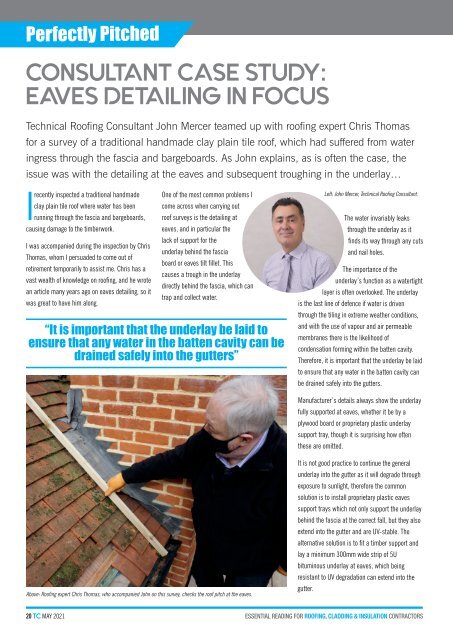May 2021
Create successful ePaper yourself
Turn your PDF publications into a flip-book with our unique Google optimized e-Paper software.
Perfectly Pitched<br />
CONSULTANT CASE STUDY:<br />
EAVES DETAILING IN FOCUS<br />
Technical Roofing Consultant John Mercer teamed up with roofing expert Chris Thomas<br />
for a survey of a traditional handmade clay plain tile roof, which had suffered from water<br />
ingress through the fascia and bargeboards. As John explains, as is often the case, the<br />
issue was with the detailing at the eaves and subsequent troughing in the underlay…<br />
Irecently inspected a traditional handmade<br />
clay plain tile roof where water has been<br />
running through the fascia and bargeboards,<br />
causing damage to the timberwork.<br />
I was accompanied during the inspection by Chris<br />
Thomas, whom I persuaded to come out of<br />
retirement temporarily to assist me. Chris has a<br />
vast wealth of knowledge on roofing, and he wrote<br />
an article many years ago on eaves detailing, so it<br />
was great to have him along.<br />
One of the most common problems I<br />
come across when carrying out<br />
roof surveys is the detailing at<br />
eaves, and in particular the<br />
lack of support for the<br />
underlay behind the fascia<br />
board or eaves tilt fillet. This<br />
causes a trough in the underlay<br />
directly behind the fascia, which can<br />
trap and collect water.<br />
“It is important that the underlay be laid to<br />
ensure that any water in the batten cavity can be<br />
drained safely into the gutters”<br />
Left: John Mercer, Technical Roofing Consultant.<br />
The water invariably leaks<br />
through the underlay as it<br />
finds its way through any cuts<br />
and nail holes.<br />
The importance of the<br />
underlay’s function as a watertight<br />
layer is often overlooked. The underlay<br />
is the last line of defence if water is driven<br />
through the tiling in extreme weather conditions,<br />
and with the use of vapour and air permeable<br />
membranes there is the likelihood of<br />
condensation forming within the batten cavity.<br />
Therefore, it is important that the underlay be laid<br />
to ensure that any water in the batten cavity can<br />
be drained safely into the gutters.<br />
Manufacturer’s details always show the underlay<br />
fully supported at eaves, whether it be by a<br />
plywood board or proprietary plastic underlay<br />
support tray, though it is surprising how often<br />
these are omitted.<br />
Above: Roofing expert Chris Thomas, who accompanied John on this survey, checks the roof pitch at the eaves.<br />
It is not good practice to continue the general<br />
underlay into the gutter as it will degrade through<br />
exposure to sunlight, therefore the common<br />
solution is to install proprietary plastic eaves<br />
support trays which not only support the underlay<br />
behind the fascia at the correct fall, but they also<br />
extend into the gutter and are UV-stable. The<br />
alternative solution is to fit a timber support and<br />
lay a minimum 300mm wide strip of 5U<br />
bituminous underlay at eaves, which being<br />
resistant to UV degradation can extend into the<br />
gutter.<br />
20 TC MAY <strong>2021</strong>

















